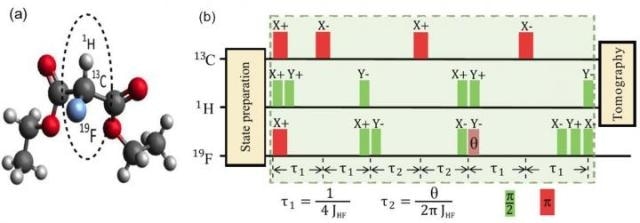Mar 15 2016
The two major pillars of modern physics are relativity theory and quantum mechanics, and several new phenomena have been discovered with their combination. For example, a major outcome of the quantum field theory is the Unruh effect, which acts as a critical tool to study a number of phenomena, including particles that are thermally emitted from cosmological horizons and black holes.
 (a) The NMR quantum simulator consists of 13C, 1H and 19F nuclear spins in chloroform; (b) The experimental pulse sequence for simulating the Unruh effect. (CREDIT ©Science China Press).
(a) The NMR quantum simulator consists of 13C, 1H and 19F nuclear spins in chloroform; (b) The experimental pulse sequence for simulating the Unruh effect. (CREDIT ©Science China Press).
As much as four decades have passed since the time the Unruh effect was discovered, but this effect is not strong enough to be viewed with present-day methods. A number of efforts have been made to explore the observational proof of the Unruh effect, but despite this, the experimental observation continues to be a major problem.
This problem could possibly be resolved using quantum simulators. Quantum simulation is extensively used to simulate quantum systems. However efficient simulation of these systems cannot be done through standard computers, or they cannot be traced directly through existing lab-based methods.
Researchers from the University of Science and Technology have used an NMR quantum simulator to demonstrate the experimental simulation of the Unruh effect. A Bruker Avance III 400 MHz spectrometer was used to carry out the experiments, where a sample of 19F, 1H and 13C nuclear spins in chloroform was used as the NMR quantum simulator. The Unruh effect, simulated on the quantum states, can be achieved through the pulse sequence acting upon the sample.
With the aid of the quantum simulator, the team demonstrated the behavior/activity of Unruh temperature with respect to acceleration, which was found to be in good agreement with the hypothetical prediction. In addition, the researchers also studied the quantum correlations that were measured by the quantum conflict observed between a pair of fermionic modes, as witnessed by two fairly accelerated observers.
For the first time it has been demonstrated that the Unruh effect can be used to produce the quantum correlations from the traditionally correlated states. The study, headed by Professor Jiangfeng Du from the University of Science and Technology of China, has been reported in the Science China-Physics, Mechanics & Astronomy.
In 1982, Feynman conceived the concept of quantum simulation. The Unruh effect continued to remain a mysterious and unexplored challenge for Feynman until his death in 1988. It is hoped that the quantum simulation of the Unruh effect will give a new avenue to study the quantum physics of accelerated systems further, because such systems are extensively seen in particle physics, cosmology, and black hole physics.